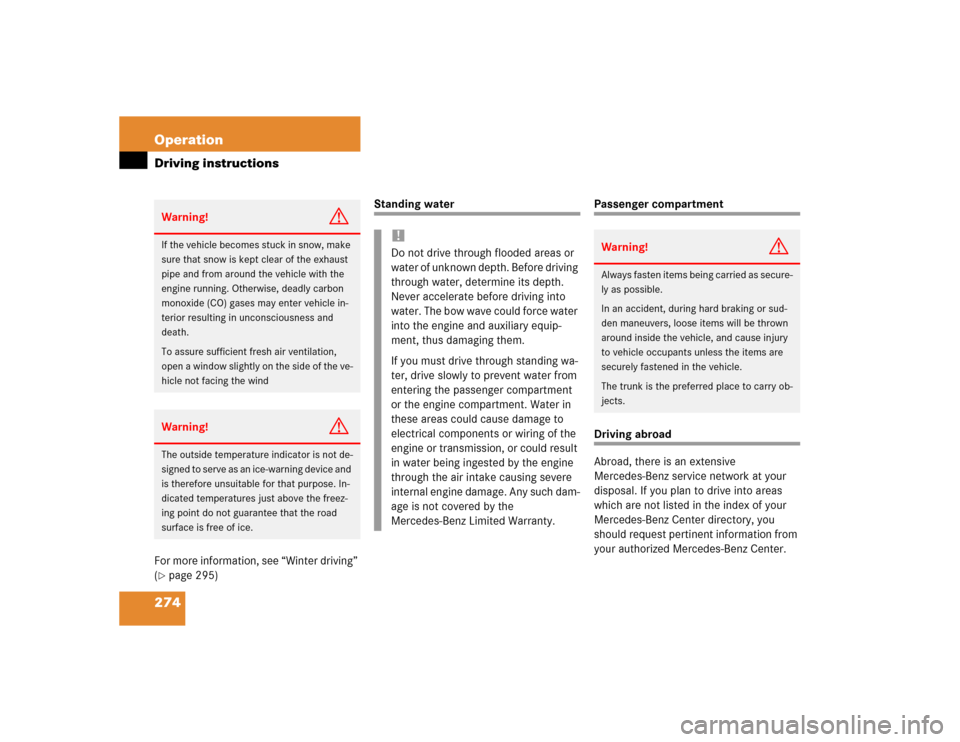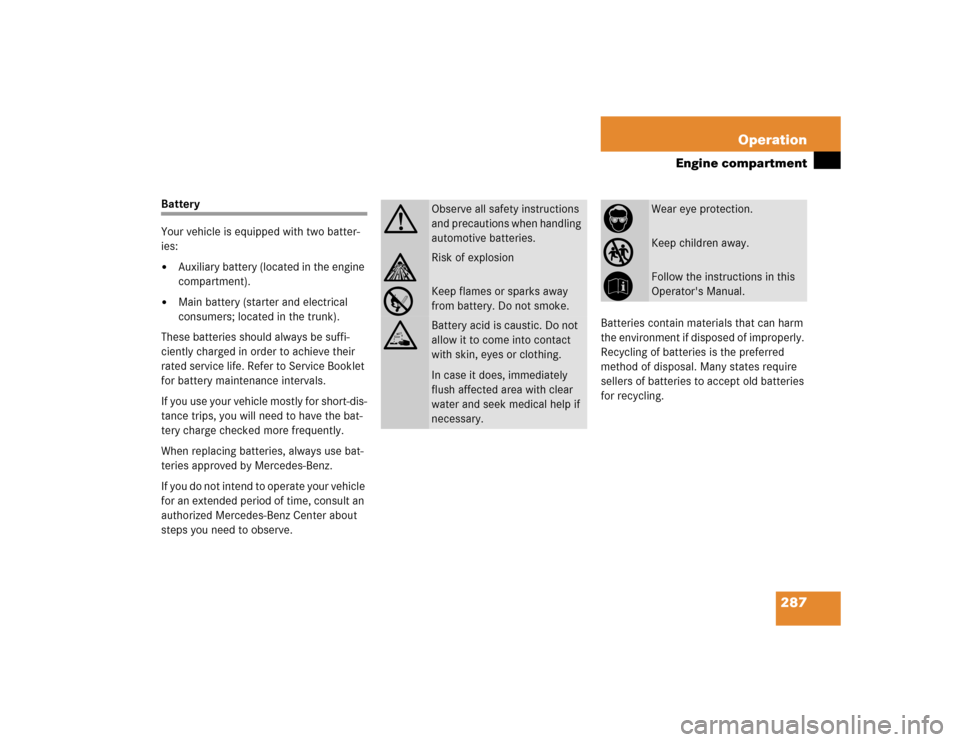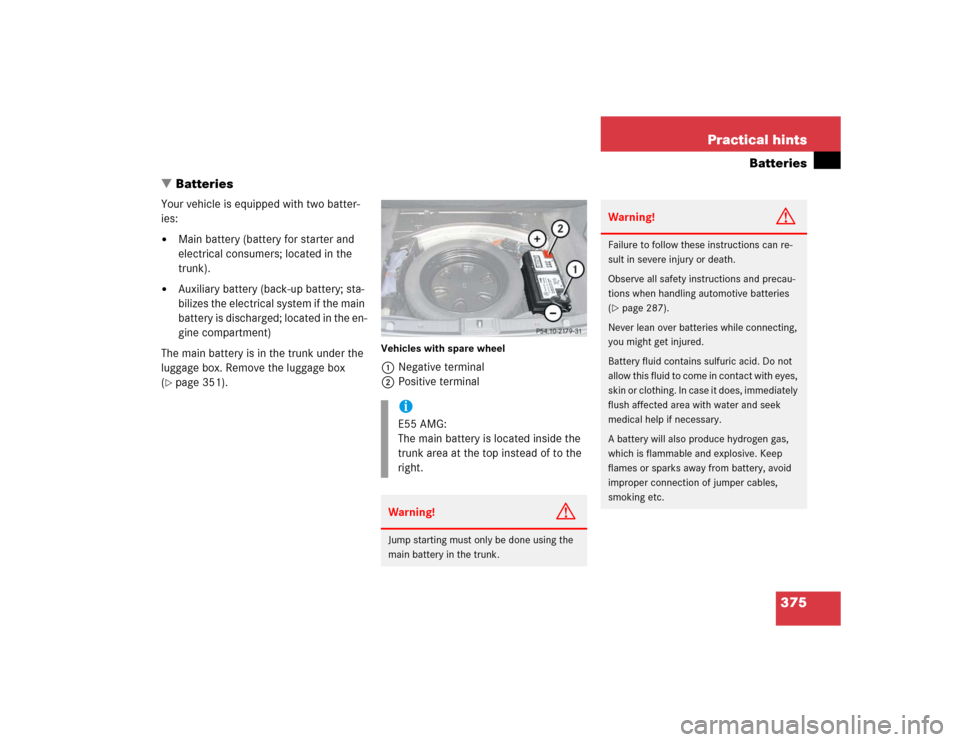Page 274 of 442

274 OperationDriving instructionsFor more information, see “Winter driving”
(�page 295)
Standing water
Passenger compartmentDriving abroad
Abroad, there is an extensive
Mercedes-Benz service network at your
disposal. If you plan to drive into areas
which are not listed in the index of your
Mercedes-Benz Center directory, you
should request pertinent information from
your authorized Mercedes-Benz Center.
Warning!
G
If the vehicle becomes stuck in snow, make
sure that snow is kept clear of the exhaust
pipe and from around the vehicle with the
engine running. Otherwise, deadly carbon
monoxide (CO) gases may enter vehicle in-
terior resulting in unconsciousness and
death.
To assure sufficient fresh air ventilation,
open a window slightly on the side of the ve-
hicle not facing the windWarning!
G
The outside temperature indicator is not de-
signed to serve as an ice-warning device and
is therefore unsuitable for that purpose. In-
dicated temperatures just above the freez-
ing point do not guarantee that the road
surface is free of ice.
!Do not drive through flooded areas or
water of unknown depth. Before driving
through water, determine its depth.
Never accelerate before driving into
water. The bow wave could force water
into the engine and auxiliary equip-
ment, thus damaging them.
If you must drive through standing wa-
ter, drive slowly to prevent water from
entering the passenger compartment
or the engine compartment. Water in
these areas could cause damage to
electrical components or wiring of the
engine or transmission, or could result
in water being ingested by the engine
through the air intake causing severe
internal engine damage. Any such dam-
age is not covered by the
Mercedes-Benz Limited Warranty.
Warning!
G
Always fasten items being carried as secure-
ly as possible.
In an accident, during hard braking or sud-
den maneuvers, loose items will be thrown
around inside the vehicle, and cause injury
to vehicle occupants unless the items are
securely fastened in the vehicle.
The trunk is the preferred place to carry ob-
jects.
Page 287 of 442

287 Operation
Engine compartment
Battery
Your vehicle is equipped with two batter-
ies:�
Auxiliary battery (located in the engine
compartment).
�
Main battery (starter and electrical
consumers; located in the trunk).
These batteries should always be suffi-
ciently charged in order to achieve their
rated service life. Refer to Service Booklet
for battery maintenance intervals.
If you use your vehicle mostly for short-dis-
tance trips, you will need to have the bat-
tery charge checked more frequently.
When replacing batteries, always use bat-
teries approved by Mercedes-Benz.
If you do not intend to operate your vehicle
for an extended period of time, consult an
authorized Mercedes-Benz Center about
steps you need to observe.Batteries contain materials that can harm
the environment if disposed of improperly.
Recycling of batteries is the preferred
method of disposal. Many states require
sellers of batteries to accept old batteries
for recycling.
G
Observe all safety instructions
and precautions when handling
automotive batteries.
A
Risk of explosion
D
Keep flames or sparks away
from battery. Do not smoke.
B
Battery acid is caustic. Do not
allow it to come into contact
with skin, eyes or clothing.
In case it does, immediately
flush affected area with clear
water and seek medical help if
necessary.
E
Wear eye protection.
C
Keep children away.
F
Follow the instructions in this
Operator's Manual.
Page 375 of 442

375 Practical hints
Batteries
�Batteries
Your vehicle is equipped with two batter-
ies:�
Main battery (battery for starter and
electrical consumers; located in the
trunk).
�
Auxiliary battery (back-up battery; sta-
bilizes the electrical system if the main
battery is discharged; located in the en-
gine compartment)
The main battery is in the trunk under the
luggage box. Remove the luggage box
(
�page 351).
Vehicles with spare wheel1Negative terminal
2Positive terminal
iE55 AMG:
The main battery is located inside the
trunk area at the top instead of to the
right. Warning!
G
Jump starting must only be done using the
main battery in the trunk.
Warning!
G
Failure to follow these instructions can re-
sult in severe injury or death.
Observe all safety instructions and precau-
tions when handling automotive batteries
(�page 287).
Never lean over batteries while connecting,
you might get injured.
Battery fluid contains sulfuric acid. Do not
allow this fluid to come in contact with eyes,
skin or clothing. In case it does, immediately
flush affected area with water and seek
medical help if necessary.
A battery will also produce hydrogen gas,
which is flammable and explosive. Keep
flames or sparks away from battery, avoid
improper connection of jumper cables,
smoking etc.
Page 397 of 442
397 Technical data
Electrical system
�Electrical system
Model
E320/E3204MATIC
E500/E5004MATIC
E55AMG
Generator (alternator)
14 V / 150 A
14 V / 150 A
14 V / 180 A
Starter motor
14 V / 1.4 kW
14 V / 1.7 kW
14 V / 1.7 kW
Battery (auxiliary)
12 V / 12 Ah
12 V / 12 Ah
12 V / 12 Ah
Battery (main)
12 V/95 Ah
12 V / 95 Ah
12 V / 95 Ah
Spark plugs
Bosch F8 DPP 332U
NGK PFR 5R-11
Bosch F8 DPP 332U
NGK PFR 5R-11
NGK IL FR 6 A
Electrode gap
0.039 in (1.00 mm)
0.039 in (1.00 mm)
0.031 in (0.8 mm)
Tightening torque
18.5 - 22 lb-ft (25 - 30 Nm)
18.5 - 22 lb-ft (25 - 30 Nm)
18.5 - 22 lb-ft (25 - 30 Nm)